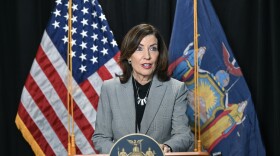First September 11, then hurricanes, flooding and superstorms -- New York state has had to deal with its fair share of disasters, both natural and manmade. But what has the state learned from these events to help us deal with future catastrophes? This week on WRVO's health and wellness show "Take Care," hosts Lorraine Rapp and Linda Lowen speak with Commissioner Jerome Hauer of the New York State Division of Homeland Security and Emergency Services about what has been done to prepare for the next big crisis.
Lorraine Rapp: So how do you determine what the biggest threats to New York state are and then, follow up, how does Homeland Security prepare for a disaster when you’re not sure what form it will take or where it’s going to come from?
Jerome Hauer: Well, what we do in the state is we do worst case planning. We look at every county in the state and we tell them they have got to look at what could happen in the county that is their worst nightmare. So it depends on where you’re looking at but, basically, we give the counties the latitude to look at what their worst nightmare could be. Our philosophy is if you’re prepared for the worst, you can pretty much handle anything. We’re also encouraging the counties to form regional consortia so there are good communications, good sharing of resources; it’s more cost-effective and good training and drilling together.
Linda Lowen: At what point does the New York State Division of Homeland Security and Emergency Services step in?
Hauer: We know our counties. We have regional coordinators, regional directors that work with the counties day in and day out. We’re also the only state in the country that has ever evaluated preparedness. We have figured out a way to go in and evaluate what a prepared county is and what a prepared state is. And if they need help, we can mobilize that help very quickly. One of the things that the governor wanted to do is put nine stockpiles around the state. If a county is in trouble we can go in with pretty much any kid of equipment to support them extremely quickly.
Rapp: Reading about Gov. Cuomo’s idea of asking certain gas stations in evacuation routes to have backup generators because I know that was something – just individuals -- that couldn’t leave because all the gas stations lost electricity. Would you speak to that?
Hauer: One of the things we learned during Sandy -- there was an enormous amount of fuel in the ground in tanks. The problem was: there was no power so we couldn’t get it out. So, the governor put money into, along major routes. Gas stations now have electrical panels to hook up generators and we’re giving them generators as well. So, they have the option of getting a panel and a generator. Or just having a panel in place and getting their own generator. The other thing that the governor wants, and is in place, we have three million gallons of diesel and gasoline out on Long Island. We’re putting two more of those reserve facilities in place around the state.
More of this interview can be heard on "Take Care," WRVO's health and wellness show Sunday at 6:30 p.m. Support for this story comes from the Health Foundation for Western and Central New York.







